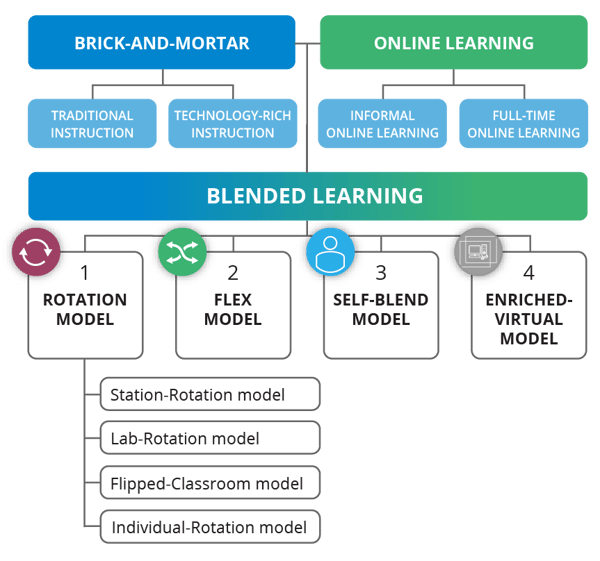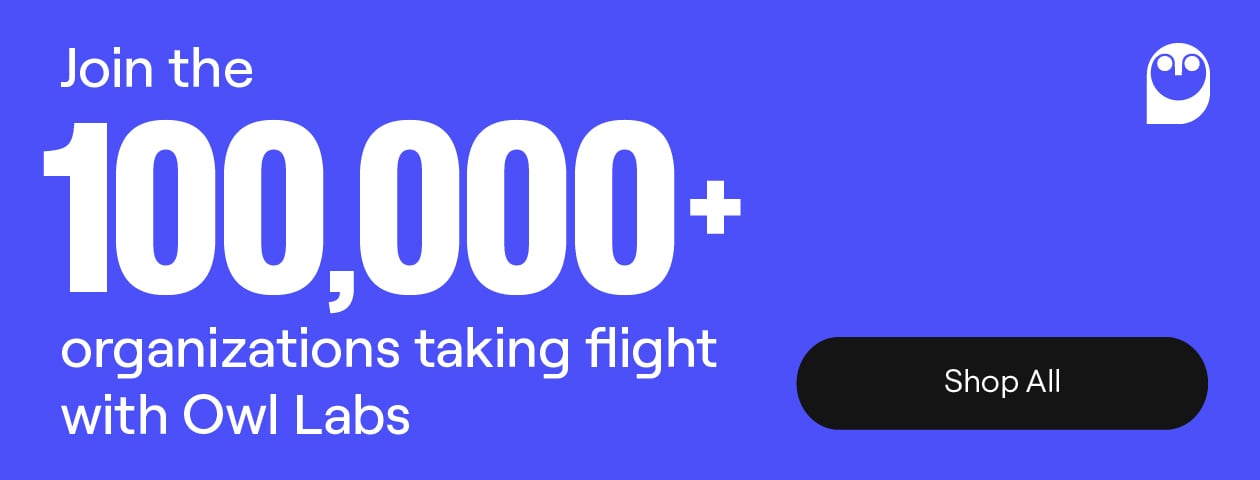With the rise of education technology, schools have adopted teaching methods that diverge from the typical classroom environment. Distance learning is being used globally, and many educational institutions have implemented hybrid learning models.
However, hybrid learning is more than just tossing half of your syllabus into a virtual classroom. Instead, it's a comprehensive approach combining the best parts of face-to-face and online learning to create the ideal learning experience.
What is hybrid learning?
Hybrid learning is an educational model where some students attend class in-person, while others join the class virtually from home. Educators teach remote and in-person students at the same time using tools like video conferencing hardware and software.
In some cases, hybrid classes include asynchronous learning elements, like online exercises and pre-recorded video instruction, to support face-to-face classroom sessions. When planned well, hybrid courses combine the best aspects of in-person and online learning while making education more attainable for many students.
For hybrid learning to be successful, the elements of your hybrid course need to be tailored to the learning format, whether it be in-person or online.
Hybrid vs. blended learning
Hybrid learning and blended learning can often be mistaken for one another, and both contain many of the same instructional elements. However, both are two distinct learning models.
Blended learning combines in-person teaching with asynchronous learning methods, where students work on online exercises and watch instructional videos during their own time.
Hybrid learning is a teaching method where teachers instruct in-person and remote students at the same time. In hybrid learning models, asynchronous teaching methods can be used to supplement synchronous, face-to-face instruction.
Benefits of hybrid learning
Both face-to-face and online learning have their benefits and weaknesses. The goal of hybrid learning is to combine the two formats to create a singular learning experience without any weak spots. The benefits of hybrid learning are:
A flexible learning experience
Many schools transition to hybrid learning for flexibility: a flexible learning schedule, flexibility in teaching modes, flexibility in how students engage with their learning materials, and flexibility in collaboration and communication between peers and instructors. For students who can't attend classes in-person, the hybrid learning environment allows them to learn remotely from home.
Synchronous communication opportunities
Few learning experiences match the immediacy and intimacy of in-person academic discussions. The face-to-face aspect of hybrid learning benefits from the opportunity for real-time engagement between peers.
This time is best used for synchronous group work, presentations with a Q&A portion, and deep conversations. Take advantage of your in-person time together to form meaningful academic relationships, then take those online.
The freedom of independent academic exploration
Online learning comes with many freedoms. Those students who excel at self-management and independent learning will thrive under these freedoms: the freedom to learn from the location of their choosing, the freedom to revisit materials any number of times at any pace, and the freedom to develop an in-depth asynchronous discourse with your peers.
More efficient use of resources
Just like attending a meeting that you know could have been an email, attending an in-person class where all the students are doing individual virtual work can be frustrating. When planning your syllabus and scheduling which classes will take place online and which are face-to-face, consider what resources you will need for each lesson and plan accordingly, optimizing the use of resources.
Hybrid Learning Model
Hybrid learning models come in many forms, depending on the content and instructor's expectations for the course. The above example highlights one way to combine virtual and in-person learning, created by the Christensen Institute.

Source: Christensen Institute
When creating your hybrid learning model, the College of DuPage offers a jumping-off point with its hybrid teaching workbook. This hybrid learning model provides you with a foundation and step-by-step instructions for setting up your hybrid class
Hybrid learning model class structure
When structuring your new hybrid course, give yourself ample time to plan your materials and activities. The focus of planning a hybrid class is to ensure that each assignment is done in the correct format, as opposed to a strictly in-person or online class where you know the medium of each assignment.
But how do you determine which materials are best served through which medium? First, gather your course materials. Then, follow our step-by-step guide.
How to create a successful hybrid learning environment
1. Set your semester goals
What do you plan to accomplish with your hybrid class? By setting long and short-term goals for yourself and your class, you can explain the key expectations to your students.
Determine these goals and their corresponding assessment, and work backward to structure the rest of your course. This backtracking from the end of the semester to your very first session will ensure that all of your assignments and materials serve your course directly.
2. Map it out
Now that you've determined the goals of your course and how your students will be assessed, you'll need to map out how they'll navigate your class. Create a chart, table, timeline, or another visual tool to outline your course modules and their respective activities and resources chronologically. By mapping your course visually, it will be easier for you to spot any course holes or underdeveloped activities.
3. Determine which course objectives are best served as in-person activities
Now that you've determined what your course will look like, it's time to factor in the hybrid element. Your face-to-face class time should be reserved for activities that require activities such as:
- Synchronous group brainstorming sessions
- Communicating class expectations and outlining individual responsibilities
- Establishing a collaborative, trust-based learning environment
- Call and response presentations
- Providing immediate feedback to students
Pro tip: Remember that synchronous, face-to-face time can happen in-person, or virtually. If some students are in the classroom while others are learning from home, you can use video conferencing tools to connect.
4. Determine the online portion of your course
One central element of your hybrid course that is not mentioned in the face-to-face section is the deliverance of information. While in-person time is reserved for synchronous and group discussions, most personal assignments will be done virtually. Additionally, the other activities that make up the online portion of your hybrid class can include:
- Self-paced learning and activity completion
- Automatic grading programs such as multiple choice of true/false quizzes
- Asynchronous group discussions
- Written critical analysis and thoughtful discourse
- Video or aural content consumption
5. Create and source content
Once you've mapped out the modules in your course, you'll need to create and source the content that your students will use. This is the time to create assignments, find all reading materials, source your video content, and finalize your syllabus.
If your school has experience with hybrid classes, adapting archived resources and tailoring them to fit your class structure is a great place to start. Additionally, resources can be found on flagship education websites and managing discussion forums.
6. Give your hybrid learning plan a trial run
Congratulations, you've created a successful hybrid learning environment! The only thing left to do before your course begins is to do a trial run of the online portion of your course. You want your course to be fluid and accessible without encountering any surprise technology speed bumps along the way. If possible, have a fellow faculty member or trusted former student test the course for you. Having an extra set of eyes on your course is always a good idea, and those unfamiliar with the creation of your course will be more likely to spot gray areas.
Hybrid teaching tips
To ensure your new hybrid course runs smoothly, here are some bonus hybrid teaching tips just for you:
- Don't be afraid to redesign. The course map you created is not set in stone; as you move through the semester, lean into the strengths that arise and redesign it to accommodate any weaknesses that are exposed.
- Use online work to offer targeted learning plans, extensions, or one-on-one teaching for individual students.
- Provide mobile learning options for the online portion of your course.
- Be open to feedback, and learn from your student's experiences.
- Don't overload yourself with online assignments; just because they can be completed anywhere doesn't mean they take less time than face-to-face work.
- Integrate the online and the in-person. A successful hybrid course is only as strong as the relationship between its two halves.
- Embrace your hybrid community. If you are stuck or frustrated, turn to other hybrid class instructors you respect: their experience and wisdom are priceless.
- Explain the purpose and expectations of your hybrid class clearly and often. If this format is new to you, it is likely new to your students, too.
- Provide students with self and time-management tips so they aren't left treading water as soon as they leave the classroom. This is especially helpful for students who have never completed online coursework before.
- Connect your students to a trusted IT hotline for any technical issues.
Just as academia has embraced the world of hybrid experiences, so has the modern workforce.
%20(1).png)
Better meetings start here
From huddle rooms to boardrooms and everything in between, we’ve got you covered with solutions that take teamwork to the next level.
Shop Solutions
